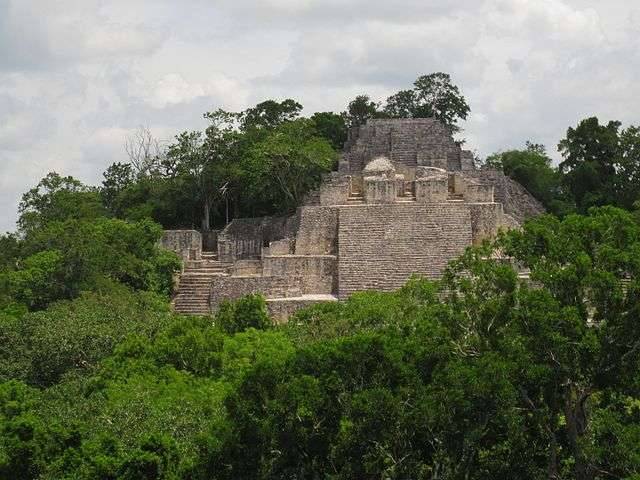Calakmul, located in the Mexican state of Campeche, is a significant archaeological site that was once one of the most powerful ancient Maya cities. It is known for its impressive pyramids, extensive urban sprawl, and rich history. The city played a crucial role in the political dynamics of the Maya region, often clashing with another major city, Tikal. Calakmul’s ruins, hidden within the dense forests of the Petén Basin, offer a glimpse into the life, culture, and politics of the ancient Maya civilization.
Get your dose of History via Email
Historical Background of Calakmul
Calakmul was discovered in 1931 by Cyrus L. Lundell, an American botanist. He named it after the nearby Mexican village of Calakmul. The site’s exploration began in the 1980s, revealing its significance. The Maya built Calakmul, with its construction dating back to the Late Preclassic period (300 BC – AD 250). It became one of the most dominant cities during the Classic period (AD 250-900).
The city was a major power in the Maya lowlands, engaging in prolonged rivalry with Tikal. This conflict shaped the political landscape of the region. Calakmul’s influence extended through a vast network of alliances and subordinate sites. The city’s power waned in the late Classic period, and it was eventually abandoned.
Calakmul was not only a political center but also a cultural and religious hub. It housed a significant population, which included the elite, artisans, and farmers. The city’s architecture and art reflect the sophistication of Maya civilization. Calakmul was the scene of important historical events, including royal ceremonies and political intrigue.
After its abandonment, Calakmul remained hidden by the jungle until its rediscovery. The site has since been the focus of archaeological research. It provides valuable insights into Maya politics, economy, and environment. Calakmul’s history is still being pieced together through ongoing excavations and studies.
The city’s rediscovery and subsequent research have shed light on the complexity of Maya society. Calakmul’s extensive inscriptions and monuments have been crucial in understanding Maya history. The site has also revealed information about later inhabitants, including evidence of reoccupation in the Postclassic period (AD 900-1500).
About Calakmul
Calakmul is one of the largest known Maya cities, with a central urban area covering approximately 2 square kilometers. It features over 6,750 ancient structures, the most prominent being the massive pyramids and complexes. The site’s core is composed of two large plazas surrounded by monumental architecture, including palaces and temples.
The Great Pyramid of Calakmul, also known as Structure II, is one of the tallest Maya structures. It stands at over 45 meters in height. The pyramid served as a royal tomb and a place for rituals. Calakmul’s builders used limestone for construction, which was abundant in the region.
Architectural highlights include intricately carved stelae and altars that depict rulers and gods. The city’s layout reflects the Maya cosmological concept, with the central axis aligning with celestial events. Calakmul’s urban design showcases the advanced engineering and architectural skills of the Maya.
The site’s reservoirs and system of causeways, known as sacbeob, highlight the Maya’s ability to adapt to their environment. These features allowed for water collection and transportation within the city. The causeways also connected Calakmul to other nearby Maya sites, facilitating trade and communication.
Calakmul’s art and architecture provide a wealth of information about the city’s social and political organization. The hieroglyphic inscriptions found on stelae are a key source for understanding Maya history. They record significant events, such as battles, alliances, and royal successions.
Theories and Interpretations
Several theories exist about Calakmul’s role and influence in the Maya world. Some scholars suggest it was a superpower, exerting control over a vast territory. Others believe it functioned more as a hub in a network of city-states.
The city’s rivalry with Tikal is well-documented, but the reasons behind their conflict are still debated. Some interpretations point to competition for resources, while others suggest ideological or dynastic disputes. The extensive inscriptions at Calakmul provide clues but also leave room for interpretation.
Mysteries surround Calakmul, including the reasons for its eventual decline and abandonment. Theories range from environmental degradation to internal strife and external pressures. The exact causes remain a subject of ongoing research and debate.
Archaeologists have used various methods to date Calakmul’s structures and artifacts. Radiocarbon dating and analysis of ceramic styles have been instrumental. These techniques help establish a timeline for the city’s development and decline.
Interpretations of Calakmul’s art and inscriptions often require matching them with historical records from other Maya sites. This comparative approach has helped reconstruct the political and social landscape of the Classic Maya period. However, many aspects of Calakmul’s history are still being unraveled.
At a glance
Country: Mexico
Civilization: Maya
Age: Late Preclassic period (300 BC – AD 250) to Postclassic period (AD 900-1500)
Conclusion and Sources
Reputable sources used in creating this article:
- Wikipedia: https://en.wikipedia.org/wiki/Calakmul
- UNESCO World Heritage Centre: https://whc.unesco.org/en/list/1061/

